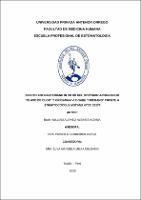Mostrar el registro sencillo del ítem
Efecto antibacteriano in vitro del syzygium aromaticum "clavo de olor" y origanum vulgare "orégano" frente a streptococcus muntans atcc 25175
| dc.contributor.advisor | Schreiber Cueva, Priscila | |
| dc.contributor.author | Albines Nizama, William Alonso | |
| dc.creator | Albines Nizama, William Alonso | |
| dc.date.accessioned | 2020-02-14T19:55:02Z | |
| dc.date.available | 2020-02-14T19:55:02Z | |
| dc.date.issued | 2020 | |
| dc.identifier.uri | https://hdl.handle.net/20.500.12759/5990 | |
| dc.description.abstract | Evaluar el efecto antibacteriano in vitro del syzygium aromaticum “clavo de olor” y origanum vulgare “orégano” frente al streptococcus mutans ATCC 25175. Material y método: El presente estudio de corte transversal, comparativo, se realizó mediante el método de difusión en agar con disco de Kirby – Bauer para evaluar la sensibilidad bacteriana. Se obtuvieron aceites esenciales de orégano y clavo de olor de la empresa de aromaterapia Ekala, ambos a una concentración del 100%. Asimismo, se consiguió la cepa de Streptococcus mutans ATCC 25175 del laboratorio GenLab del Perú Sac; donde cada cepa se cultivó en placas Petri en agar Müller Hinton y se colocaron discos de papel filtro embebidos con aceites esenciales de clavo de olor y orégano a una concentración del 100% cada una. Estos aceites esenciales fueron comparados con Gluconato de clorhexidina al 0.12% como grupo control. Posteriormente, se incubaron a 37° C por 24 horas, para luego realizar la medición del diámetro del halo de inhibición. Para la confiabilidad de este estudio, se utilizó el método estadístico Kappa. Para el análisis de resultados se empleó el programa estadístico SPSS versión 23 y Excel, para luego presentar los resultados en tablas y gráficos. Resultados: Al evaluar el efecto antibacteriano in vitro del Syzygium aromaticum “clavo de olor” y Origanum vulgare “orégano” frente al Streptococcus mutans ATCC 25175, se observó que el halo de inhibición del Syzygium aromaticum (100%) tuvo un promedio de 20.09 mm ± 1.87mm, mientras que el halo de inhibición del Origanum vulgare tuvo un promedio de 14.74 mm ± 0.41. Conclusiones: Se concluye que el mayor promedio fue del Syzygium aromaticum (100%) con un halo de 20.09mm y el menor promedio fue para el Gluconato de Clorhexidina (0,12%) con un halo de 10.63mm. | es_PE |
| dc.description.abstract | To evaluate the in vitro antibacterial effect of Syzygium aromaticum “clove” and Origanum vulgare “oregano” against Streptococcus mutans ATCC 25175. Material and method: This comparative cross-sectional study was carried out using the Kirby-Bauer disc agar diffusion method to evaluate bacterial sensitivity. Essential oils of oregano and clove were obtained from the aromatherapy company Ekala, both at a concentration of 100%. Likewise, the Streptococcus mutans ATCC 25175 strain was obtained from the GenLab laboratory in Peru Sac; where each strain was grown in Petri dishes in Müller Hinton agar and filter paper discs embedded with essential oils of clove and oregano were placed at a concentration of 100% each. These essential oils were compared with 0.12% chlorhexidine gluconate as a control group. Subsequently, they were incubated at 37 ° C for 24 hours, and then measured the diameter of the inhibition halo. For the reliabil ity of this study, the Kappa statistical method was used. For the analysis of results, the statistical program SPSS version 23 and Excel was used, to then present the results in tables and graphs. Results: When evaluating the in vitro antibacterial effect of Syzygium aromaticum ““clove““ and Origanum vulgare ““oregano““ against Streptococcus mutans ATCC 25175, it was observed that the inhibition halo of Syzygium aromaticum (100%) had an average of 20.09 mm ± 1.87 mm, while the origanum vulgare inhibition halo averaged 14.74 mm ± 0.41. Conclusions: It is concluded that the highest average was Syzygium aromaticum (100%) with a halo of 20.09mm and the lowest average was for Chlorhexidine Gluconate (0.12%) with a halo of 10.63mm. | en_US |
| dc.description.uri | Tesis | es_PE |
| dc.format | application/pdf | es_PE |
| dc.language.iso | spa | es_PE |
| dc.publisher | Universidad Privada Antenor Orrego - UPAO | es_PE |
| dc.relation.ispartofseries | T_ESTO_627 | |
| dc.rights | info:eu-repo/semantics/openAccess | es_PE |
| dc.source | Universidad Privada Antenor Orrego | es_PE |
| dc.source | Repositorio institucional - UPAO | es_PE |
| dc.subject | Aceites Esenciales | es_PE |
| dc.subject | Efecto Antibacteriano | es_PE |
| dc.title | Efecto antibacteriano in vitro del syzygium aromaticum "clavo de olor" y origanum vulgare "orégano" frente a streptococcus muntans atcc 25175 | es_PE |
| dc.type | info:eu-repo/semantics/bachelorThesis | es_PE |
| thesis.degree.level | Título Profesional | es_PE |
| thesis.degree.grantor | Universidad Privada Antenor Orrego. Facultad de Medicina Humana | es_PE |
| thesis.degree.name | Cirujano Dentista | es_PE |
| thesis.degree.discipline | Estomatología | es_PE |
Ficheros en el ítem
Este ítem aparece en la(s) siguiente(s) colección(es)
-
Estomatología [567]

